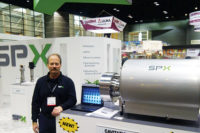Aluminium Plant & Vessel Co. (APV) founder Richard Seligman is credited with the invention of the plate heat exchanger, and APV’s R5 plate was dominant in this method of indirect heating and cooling of fluids throughout the latter part of the 20th Century, beginning with its introduction in 1965.

Jon Shaw, development manager-heat exchange product group, APV Invensys Inc., Goldsboro, NC
Aluminium Plant & Vessel Co. (APV) founder Richard Seligman is credited with the invention of the plate heat exchanger, and APV’s R5 plate was dominant in this method of indirect heating and cooling of fluids throughout the latter part of the 20th Century, beginning with its introduction in 1965. R5 plates were a British invasion with legs: almost half of North American dairies and breweries still use those plates, and the platform was APV Invensys’ springboard to a wide variety of industrial heat-exchange systems.
Standing still means falling behind, however, and APV’s plate technology for food and beverage heat exchangers suffered from benign neglect. New competitors with more efficient pressing technologies and customized solutions chipped away at APV’s dominance in recent years. Industrial heat exchangers became the lion’s share of the firm’s business, discouraging development efforts. To change course, a team of thermal experts at APV’s Goldsboro, NC, facility was assembled under the direction of H. “Sam” Kumar, global R&D director-heat transfer, and Jon Shaw, development manager-heat exchangers, in 2003. Addressing issues raised in 35 years of customer feedback and technological advances over that time, the team unveiled a re-engineered binary-drive heat exchanger featuring the Vega plate at last year’s Worldwide Expo in Chicago.
Shaw is a chemical engineer. He graduated with honors from the Institute of Science and Technology at the UK’s University of Manchester in 1983 with a bachelor’s degree. He joined APV’s technical team in September 1983.
Standing still means falling behind, however, and APV’s plate technology for food and beverage heat exchangers suffered from benign neglect. New competitors with more efficient pressing technologies and customized solutions chipped away at APV’s dominance in recent years. Industrial heat exchangers became the lion’s share of the firm’s business, discouraging development efforts. To change course, a team of thermal experts at APV’s Goldsboro, NC, facility was assembled under the direction of H. “Sam” Kumar, global R&D director-heat transfer, and Jon Shaw, development manager-heat exchangers, in 2003. Addressing issues raised in 35 years of customer feedback and technological advances over that time, the team unveiled a re-engineered binary-drive heat exchanger featuring the Vega plate at last year’s Worldwide Expo in Chicago.
Shaw is a chemical engineer. He graduated with honors from the Institute of Science and Technology at the UK’s University of Manchester in 1983 with a bachelor’s degree. He joined APV’s technical team in September 1983.
FE: Where did you focus your redesign efforts?
Shaw: Overhauling the plates was the main objective. We wanted to keep the best features of the R5, which has very good heat-transfer properties, even with a large flow space, while also reducing the amount of fouling. Heat exchange efficiency and cost are less important than run time in food applications. You foul where the plates contact each other, so you want a design that minimizes the number of contact points and keeps crevices as small as possible to minimize buildup. Instead of vertical flow with a chevron design, we wanted diagonal flow through the plates, giving all the stream lines the same flow rate. The design has one-third of the contact points of a chevron plate, and the contact points have sharp radiuses. You can get away with that because the pressure in a food application is low, less than 150 psi, compared to an industrial heat exchanger, where pressure might be 300 psi.
We also redesigned the gaskets to be more operator friendly. In the past, a tension system was used. That poses problems when plates have to be opened frequently for inspection. Originally, gaskets were literally glued into place, which was messy to change. Food is notoriously sticky, anyway, and gaskets are prone to tearing, which means additional downtime. Before this project, we used a system of power clips, sprues of rubber that penetrated small holes punched into the plate. The sprues were hard to get into the holes. They were on the outside of the plate, where oxidation is worse and the clips were more likely to weaken, fatigue and break off. We replaced that design with long rubber tabs that just have to be roughly in place to clip in to the plate. It takes about a quarter of the time to change as the old system’s gaskets.
FE: What are the biggest differences between a heat exchanger designed for food applications vs. industrial applications?
Shaw: Cleanliness is very important in a food plant, so the details that make the systems more cleanable are very important. Related to that is the frequency that the seals are broken to open the plates and verify that your cleaning processes are working and to look for evidence of corrosion. More stopping and starting creates shocks and more arduous duty for the system, though the lower operating pressures for food processing make the impact less brutal. Still, the design of the food plate must be different, and those differences make it weaker.
Flowable food products tend to be non-Newtonian, and that makes uniform flow critical. Besides velocity, the shear that occurs can damage the physical properties of the liquid. Yogurt that is sheared becomes runny; the same is true of eggs and fatty products.
FE: What challenges did you face in developing new gaskets?
Shaw: Pasilac, our Danish sister company, spent several years of trial and error to come up with an industrial duty gasket for Q plates. How the gasket is formed in the die is the issue. Getting it to release properly is the challenge. I had to adapt Pasilac’s to work in a slightly different gasket form that we have here.
FE: What advantages does a diagonal flow pattern through a plate have over vertical flow?
Shaw: It’s very difficult to treat everything equally with vertical flow, and if non-Newtonian fluids are involved, it makes matters worse. A pressure gradient is put on fluid in a plate, and if you shear it, the viscosity changes and non-uniform flow rate occurs. Product on one side of the plate can be undercooked, while product on the other side is overcooked. If you’re cooling a non-Newtonian food, the fluid becomes thicker as it slows, which cools it even more. At the same time, the relative speed of fluid on the other side of the plate accelerates, and channeling occurs. A diagonal flow design moderates those differences and makes it easier to get back on track if an upset condition occurs.

A generous surface area and wide clip-in tabs simplify gasket fit in the redesigned heat exchanger plates. Source: APV Invensys.
FE: Your colleague talks about the devil in the detail of plate design. Cite an example.
Shaw: We used to form the plates, then trim them to size. By employing technology that accurately predicts how the metal will draw in the form, we now trim the metal first and then form it. We also use modeling programs like Pro/Engineer to allow us to simultaneously form the left and right sides of the plate, which is a very complex formulation: you don’t simply rotate the plate 180 degrees to get the other side, after all. We ended up with more tooling cost, but being able to manufacture plates faster drives down cost.
FE: How does the plate’s performance compare to the R5?
Shaw: The number of contact points per plate has been cut in half, and the gap sizes are considerably larger, which means less fouling and reduced need for cleaning.
Viscosities of 30,000-50,000 centipoise can be processed with the new plates, which is about the same as the old ones. The main difference is the thinner gauge of the new plates. They’re 0.6 mm thick, compared to 0.9 mm with the old. Thinner materials mean lower end-user cost.
FE: Are different materials being used in the new generation plates’ fabrication?
Shaw: We’re doing a lot of research in the area of metallurgy. The standard material for plates is 316 stainless, but chlorides create pitting and cracking. Sodium chloride is a real problem, and any food with more than 50 parts per million of salt that is going to be processed at more than 100
Shaw: We used to form the plates, then trim them to size. By employing technology that accurately predicts how the metal will draw in the form, we now trim the metal first and then form it. We also use modeling programs like Pro/Engineer to allow us to simultaneously form the left and right sides of the plate, which is a very complex formulation: you don’t simply rotate the plate 180 degrees to get the other side, after all. We ended up with more tooling cost, but being able to manufacture plates faster drives down cost.
FE: How does the plate’s performance compare to the R5?
Shaw: The number of contact points per plate has been cut in half, and the gap sizes are considerably larger, which means less fouling and reduced need for cleaning.
Viscosities of 30,000-50,000 centipoise can be processed with the new plates, which is about the same as the old ones. The main difference is the thinner gauge of the new plates. They’re 0.6 mm thick, compared to 0.9 mm with the old. Thinner materials mean lower end-user cost.
FE: Are different materials being used in the new generation plates’ fabrication?
Shaw: We’re doing a lot of research in the area of metallurgy. The standard material for plates is 316 stainless, but chlorides create pitting and cracking. Sodium chloride is a real problem, and any food with more than 50 parts per million of salt that is going to be processed at more than 100
